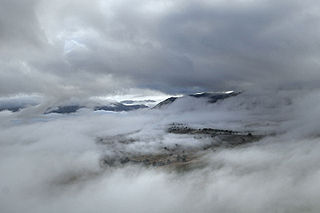
An aerosol is a suspension of fine solid particles or liquid droplets in air or another gas. Aerosols can be natural or anthropogenic. The term aerosol commonly refers to the particulate/air mixture, as opposed to the particulate matter alone. Examples of natural aerosols are fog or mist, dust, forest exudates, and geyser steam. Examples of anthropogenic aerosols include particulate air pollutants, mist from the discharge at hydroelectric dams, irrigation mist, perfume from atomizers, smoke, dust, steam from a kettle, sprayed pesticides, and medical treatments for respiratory illnesses. When a person inhales the contents of a vape pen or e-cigarette, they are inhaling an anthropogenic aerosol.
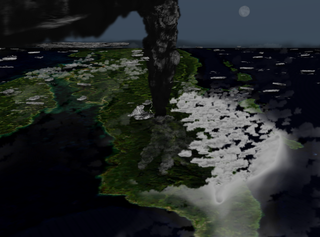
The Toba eruption was a supervolcano eruption that occurred around 74,000 years ago during the Late Pleistocene at the site of present-day Lake Toba in Sumatra, Indonesia. It is one of the largest known explosive eruptions in the Earth's history. The Toba catastrophe theory holds that this event caused a severe global volcanic winter of six to ten years and contributed to a 1,000-year-long cooling episode, leading to a genetic bottleneck in humans.
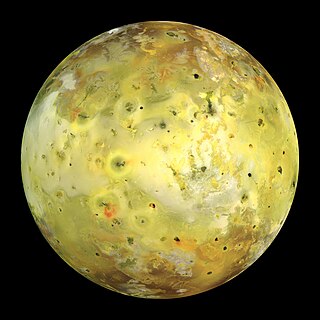
Io, or Jupiter I, is the innermost and third-largest of the four Galilean moons of the planet Jupiter. Slightly larger than Earth's moon, Io is the fourth-largest moon in the Solar System, has the highest density of any moon, the strongest surface gravity of any moon, and the lowest amount of water of any known astronomical object in the Solar System. It was discovered in 1610 by Galileo Galilei and was named after the mythological character Io, a priestess of Hera who became one of Zeus's lovers.
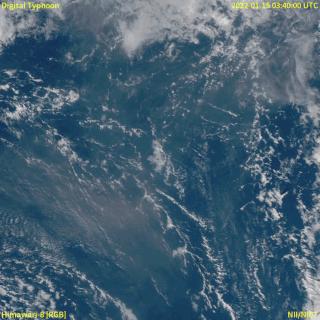
An eruption column or eruption plume is a cloud of super-heated ash and tephra suspended in gases emitted during an explosive volcanic eruption. The volcanic materials form a vertical column or plume that may rise many kilometers into the air above the vent of the volcano. In the most explosive eruptions, the eruption column may rise over 40 km (25 mi), penetrating the stratosphere. Stratospheric injection of aerosols by volcanoes is a major cause of short-term climate change.

The Yellowstone hotspot is a volcanic hotspot in the United States responsible for large scale volcanism in Idaho, Montana, Nevada, Oregon, and Wyoming, formed as the North American tectonic plate moved over it. It formed the eastern Snake River Plain through a succession of caldera-forming eruptions. The resulting calderas include the Island Park Caldera, Henry's Fork Caldera, and the Bruneau-Jarbidge caldera. The hotspot currently lies under the Yellowstone Caldera. The hotspot's most recent caldera-forming supereruption, known as the Lava Creek Eruption, took place 640,000 years ago and created the Lava Creek Tuff, and the most recent Yellowstone Caldera. The Yellowstone hotspot is one of a few volcanic hotspots underlying the North American tectonic plate; another example is the Anahim hotspot.
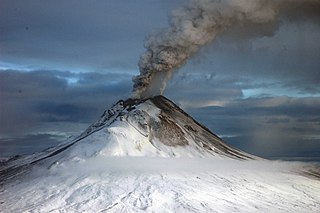
Volcanic gases are gases given off by active volcanoes. These include gases trapped in cavities (vesicles) in volcanic rocks, dissolved or dissociated gases in magma and lava, or gases emanating from lava, from volcanic craters or vents. Volcanic gases can also be emitted through groundwater heated by volcanic action.

In statistical physics, the Smoluchowski coagulation equation is a population balance equation introduced by Marian Smoluchowski in a seminal 1916 publication, describing the time evolution of the number density of particles as they coagulate to size x at time t.

Sediment transport is the movement of solid particles (sediment), typically due to a combination of gravity acting on the sediment, and the movement of the fluid in which the sediment is entrained. Sediment transport occurs in natural systems where the particles are clastic rocks, mud, or clay; the fluid is air, water, or ice; and the force of gravity acts to move the particles along the sloping surface on which they are resting. Sediment transport due to fluid motion occurs in rivers, oceans, lakes, seas, and other bodies of water due to currents and tides. Transport is also caused by glaciers as they flow, and on terrestrial surfaces under the influence of wind. Sediment transport due only to gravity can occur on sloping surfaces in general, including hillslopes, scarps, cliffs, and the continental shelf—continental slope boundary.

Several types of volcanic eruptions—during which lava, tephra, and assorted gases are expelled from a volcanic vent or fissure—have been distinguished by volcanologists. These are often named after famous volcanoes where that type of behavior has been observed. Some volcanoes may exhibit only one characteristic type of eruption during a period of activity, while others may display an entire sequence of types all in one eruptive series.
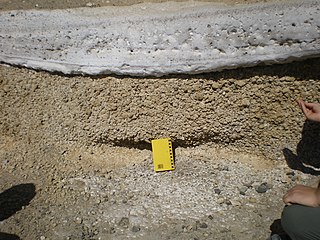
Phreatomagmatic eruptions are volcanic eruptions resulting from interaction between magma and water. They differ from exclusively magmatic eruptions and phreatic eruptions. Unlike phreatic eruptions, the products of phreatomagmatic eruptions contain juvenile (magmatic) clasts. It is common for a large explosive eruption to have magmatic and phreatomagmatic components.
Attrition is the process of erosion that occurs during rock collision and transportation. The transportation of sediment chips and smooths the surfaces of bedrock; this can be through water or wind. Rocks undergoing attrition erosion are often found on or near the bed of a stream. Attrition is also partially responsible for turning boulders into smaller rocks and eventually to sand.

The New England hotspot, also referred to as the Great Meteor hotspot and sometimes the Monteregian hotspot, is a volcanic hotspot in the North Atlantic Ocean. It created the Monteregian Hills intrusions in Montreal and Montérégie, the White Mountains intrusions in New Hampshire, the New England and Corner Rise seamounts off the coast of North America, and the Seewarte Seamounts east of the Mid-Atlantic Ridge on the African Plate, the latter of which include its most recent eruptive center, the Great Meteor Seamount. The New England, Great Meteor, or Monteregian hotspot track has been used to estimate the movement of the North American Plate away from the African Plate from the early Cretaceous period to the present using the fixed hotspot reference frame.
The CFD-DEM model, or Computational Fluid Dynamics / Discrete Element Method model, is a process used to model or simulate systems combining fluids with solids or particles. In CFD-DEM, the motion of discrete solids or particles phase is obtained by the Discrete Element Method (DEM) which applies Newton's laws of motion to every particle, while the flow of continuum fluid is described by the local averaged Navier–Stokes equations that can be solved using the traditional Computational Fluid Dynamics (CFD) approach. The interactions between the fluid phase and solids phase is modeled by use of Newton's third law.

Volcanic lightning is an electrical discharge caused by a volcanic eruption rather than from an ordinary thunderstorm. Volcanic lightning arises from colliding, fragmenting particles of volcanic ash, which generate static electricity within the volcanic plume, leading to the name dirty thunderstorm. Moist convection currents and ice formation also drive the eruption plume dynamics and can trigger volcanic lightning. Unlike ordinary thunderstorms, volcanic lightning can also occur when there are no ice crystals in the ash cloud.
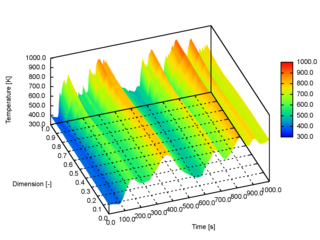
The extended discrete element method (XDEM) is a numerical technique that extends the dynamics of granular material or particles as described through the classical discrete element method (DEM) by additional properties such as the thermodynamic state, stress/strain or electro-magnetic field for each particle. Contrary to a continuum mechanics concept, the XDEM aims at resolving the particulate phase with its various processes attached to the particles. While the discrete element method predicts position and orientation in space and time for each particle, the extended discrete element method additionally estimates properties such as internal temperature and/or species distribution or mechanical impact with structures.

Volcanic ash consists of fragments of rock, mineral crystals, and volcanic glass, produced during volcanic eruptions and measuring less than 2 mm (0.079 inches) in diameter. The term volcanic ash is also often loosely used to refer to all explosive eruption products, including particles larger than 2 mm. Volcanic ash is formed during explosive volcanic eruptions when dissolved gases in magma expand and escape violently into the atmosphere. The force of the gases shatters the magma and propels it into the atmosphere where it solidifies into fragments of volcanic rock and glass. Ash is also produced when magma comes into contact with water during phreatomagmatic eruptions, causing the water to explosively flash to steam leading to shattering of magma. Once in the air, ash is transported by wind up to thousands of kilometres away.
Dispersal index is a parameter in volcanology. The dispersal index was defined by George P. L. Walker in 1973 as the surface area covered by an ash or tephra fall, where the thickness is equal or more than 1/100 of the thickness of the fall at the vent. An eruption with a low dispersal index leaves most of its products close to the vent, forming a cone; an eruption with a high dispersal index forms thinner sheet-like deposits which extends to larger distances from the vent. A dispersal index of 500 square kilometres (190 sq mi) or more of coarse pumice is one proposed definition of a Plinian eruption. Likewise, a dispersal index of 50,000 square kilometres (19,000 sq mi) has been proposed as a cutoff for an ultraplinian eruption. The definition of 1/100 of the near-vent thickness was partially dictated by the fact that most tephra deposits are not well preserved at larger distances.

In geology, numerical modeling is a widely applied technique to tackle complex geological problems by computational simulation of geological scenarios.
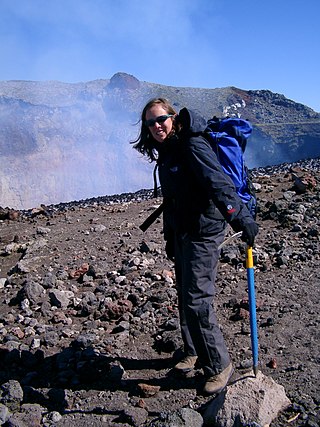
Tamsin Alice Mather is a British Professor of Earth Sciences at the Department of Earth Sciences, University of Oxford and a Fellow of University College, Oxford. She studies volcanic processes and their impacts on the Earth's environment and has appeared on the television and radio.

Costanza Bonadonna is an Italian earth scientist who is a Full Professor of volcanology and geological risk at the University of Geneva. In 2020, she was named President-Elect of volcanology, geochemistry, and petrology at the American Geophysical Union (AGU).

















